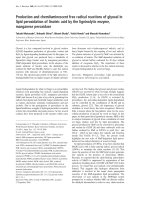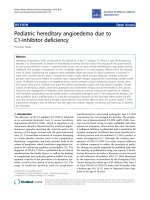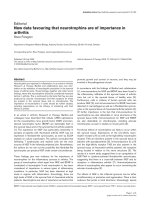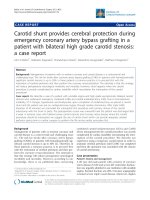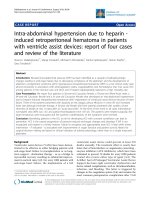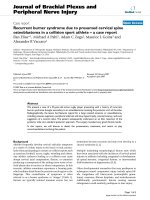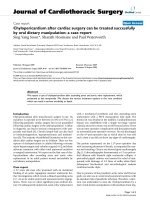Báo cáo y học: " Bilateral thalamic stroke due to occlusion of the artery of Percheron in a patient with patent foramen ovale: a case report" pot
Bạn đang xem bản rút gọn của tài liệu. Xem và tải ngay bản đầy đủ của tài liệu tại đây (403.89 KB, 4 trang )
Case report
Open Access
Bilateral thalamic stroke due to occlusion of the artery of Percheron
in a patient with patent foramen ovale: a case report
Raúl López-Serna
1
*, Patricia González-Ca rmona
2
and
Manuel López-Martínez
2
Addresses:
1
Division of Neurosurgery, Instituto Nacional de Neurología y Neurocirugía, México, DF, Mexico
2
Emergency Department, Instituto Nacional de Neurología y Neurocirugía, México, DF, Mexico
Email: RLS* - ; PGC - ; MLM -
* Corresponding author
Received: 25 May 2008 Accepted: 4 March 2009 Published: 15 September 2009
Journal of Medical Case Reports 2009, 3:7392 doi: 10.4076/1752-1947-3-7392
This article is available from: />© 2009 López-Serna et al.; licensee Cases Network Ltd.
This is an Open Access article distributed under the terms of the Creative Commons Attribution License (
/>which permits unrestricted use, distribution, and reproduction in any medium, provided the original work is properly cited.
Abstract
Introduction: Bilateral thalamic infarcts are rare presentations of stroke. They are the result of a
complex combination of risk factors and a predisposing vessel distribution. The artery of Percheron,
characterized by a single arterial trunk that irrigates both paramedian thalamic regions, can be
occluded as a result of embolic diseases leading to bilateral paramedian thalamic infarcts. Clinical and
image findings of this uncommon form of posterior circulation infarct are presented along with their
anatomic and pathophysiologic correlates.
Case presentation: A 27-year-old Mexican man with no relevant medical history was admitted to
hospital after he was found deeply stuporous. On admission, an urgent neuroimaging protocol for
stroke, including magnetic resonance imaging and magnetic resonance imaging angiography, was
performed. The scans revealed symmetric bilateral hyperintense paramedian thalamic lesions
consistent with acute ischemic events. The posterior circulation was patent including the tip of the
basilar artery and both posterior cerebral arteries, making the case compatible with occlusion of the
artery of Percheron. Further evaluation with an aim to define the etiology revealed a patent foramen
ovale as the cause of embolism.
Conclusion: Bilateral thalamic infarcts are unusual presentations of posterior circulation stroke;
once they are diagnosed by an adequate neuroimaging protocol, a further evaluation to define the
cause is necessary. Cardioembolism should always be considered in relatively young patients.
A complete evaluation should be conducted by an interdisciplinary team including neurologists,
cardiologists and neurosurgeons.
Introduction
Although infarcts restricted to the thalamus were reported
for the first time more than 100 years ago by Dejerine and
Roussy [1], they remain a rare presentation of stroke and
account for only 11% of all vertebrobasilar infarcts [2].
Bilateral involvement has been reported in a limited
Page 1 of 4
(page number not for citation purposes)
number of cases and results from a combination of
predisposing factors and anatomic variations [3- 9].
The thalamic arterial supply arises from perforating vessels
with a complex distribution [10]. The paramedian
thalamic territory is the median part of the thalamus
including the intralami nar nuclei and most of th e
dorsomedian nucleus. It is supplied by the paramedian
arteries, usually emerging directly from the first segment of
posterior cerebral arteries (P1 segment) on both sides;
however, in one-third of human brains, these originate
from a single pedicle (Figure 1) known as the type B artery
of Percheron [11,12]. Midbrain infarcts may result after
occlusion of the artery of Percheron and they are usually
limited to periaqueductal gr ay matter and affect the
oculomotor and reticular nuclei.
Strokes limited to paramedian territories account for
about 22% to 35% of all thalamic infarcts [13,14], and
their most frequent etiology is cardioembolism [15]. The
incidence of bilateral infarcts limited to this vascular
territory has not been established.
Case presentation
A 27-year-old Mexican man was admitted to our hospital
after he was found in a deep stupor. He had no previous
history of disease and did not smoke or take alcohol or
illicit drugs. On admission, his vital signs were normal
(blood pressure 125/70 mmHg, breath rate 18/minute,
heart rate 78/minute, axillary temperature 37.2°C). On
neurologic examination, we found p tosis, arreflectic
mydriasis and exophthalmos of the right eye, suggesting
that the right oculomotor nerve was affected. The left eye
opened to the Foix maneuver with normal pupil reflexes.
We further found symmetric facial responses and with-
drawal of both arms and legs to painful stimuli. All
brainstem reflexes were patent and Hoffman-Trömner and
Babinski reflexes were negative on both sides. All blood
tests were normal and illicit drug and toxic profiles were
negative. The laboratory test results were as follows:
complete blood cell count: hemoglobin 15.3, platelets
371; cholesterol profile: cholesterol 177 mg/dl, triglycer-
ides 296, high-density lipoprotein (HDL) 35 mg/dl, low-
density lipoprotein 83 mg/dl, ratio of cholesterol to HDL
5.1; anti-beta-2 glycoprotein I antibodies, anticardiolipin
(immunoglobin G and M), activated partial thromboplas-
tin time, Venereal Disease Research Laboratory, Factor V
Leiden, activated protein C and S tests were all negative.
An urgent neuroimaging protocol for stroke including
magnetic resonance imaging (MRI) and magnetic reso-
nance image angiography (angio-MRI) was carried out.
Axial and coronal trace diffusion-weighted images
obtained 20 hours after the onset of symptoms showed
bilateral areas of high signal intensity compatible with
thalamic infarcts restricted to both paramedian thalamic
territories and right periaqueductal gray matter (Figure 2).
The posterior circulation was patent on the angio-MRI,
including the tip of the basilar artery and both posterior
cerebral arteries. Further evaluation with an aim of
defining the etiology of the stroke revealed a patent
foramen ovale on transesophageal echocardiography with
spontaneous passage of contrast bubbles from the right
auricle to the left cavities. Clot formation was found in the
wall of the right auricle.
The state of consciousness spontaneously resolved during
the third week after the ictus, although fluctuant periods of
somnolence and obtundation continued. Administration
of modafinil (100 mg twice a day) markedly improved his
state of alertness, evidencing important neuropsychologic
impairment with hyperphagia, anosognosia and emo-
tional lability with depressive symptoms. T here was
improvement in the right third cranial nerve function
with adequate eye opening and orthophoric condition,
although bilateral limitation in vertical gaze movement
was persistent. The patient was discharged after two weeks
of hospitalization and was being followed up by our
outpatient clinic at the time of writing. He began medical
treatment with oral anticoagulation and was referred to a
national cardiology center for treatment of his congenital
cardiopathy. No other embolic events have occurred while
there is a pending procedure of percutaneous closure using
an Amplatzer device.
Figure 1. Schematic representation of type B artery of
Percheron emerging from the right first segment of the
posterior cerebral arteries. PA = type B artery of Percheron,
T = thalamus, AcoP = posterior communicating artery, PCA =
posterior cerebral artery, BA = basilar artery.
Page 2 of 4
(page number not for citation purposes)
Journal of Medical Case Reports 2009, 3:7392 />Discussion
Strokes affecting both paramedian thalamic territories are
unusual and may lead to a suspicion of an occlusion of a
single arterial trunk known as the artery of Percheron.
Although not visible on angio-MRI, the presence of this
anatomic variant must be suspected when bilateral
symmetric paramedian thalamic infarcts are revealed on
image studies in the context of a patent basilar artery and
posterior cerebral arteries.
The clinical pattern of this unique presentation of poster-
ior circulation stroke usually consists of varying levels of
decreased consciousness and neuropsychologic impair-
ment. In most cases, the cognitive and behavioral changes
become obvious when consciousness resumes [16].
An understanding of thalamic anatomy is important to
explain the pathophysiology of bila teral paramedian
thalamic infarction. Paramedian nuclei consist mainly of
a dorsomedian nucleus and intralaminar nuclei. The
intralaminar nuclei consist of parafascicular, centrome-
dian, central medial, paracentral and central lateral nuclei.
Smaller nuclei of the ‘midline’, such as the paraventricular,
rhomboid and reunions nuclei, are also included in the
Figure 2. Axial (right and left) and coronal (center) trace diffusion-weighted magnetic resonance images, obtained 20 hours after
the onset of symptoms, show bilateral thalamic areas of high signal intensity (white arrows) compatible with acute bilateral
paramedian thalamic infarcts. Rostral midbrain infarct is limited to right periaqueductal gray matter (empty white arrows).
Figure 3. Schematic representation of the affected thalamic nuclei in this case compared with an axial diffusion-weighted
magnetic resonance image of the same patient. The black line limits the area of infarction in both paramedian regions.
CM = centromedian, Pf = parafascicularis, Pv = paraventricular, CL = central lateral, MD = dorsomedialis.
Page 3 of 4
(page number not for citation purposes)
Journal of Medical Case Reports 2009, 3:7392 />intralaminar group (Figure 3). Both nuclear groups are
characterized by important and reciprocally activating
connections with the anterior, orbitofrontal and medial
prefrontal cortices through the thalamic peduncles
[17,18], thus explaining the neuropsychiatric impairment
and the loss of self-activation characteristic of paramedian
infarctions. The rostral midbrain can also be involved after
occlusion of the artery of Percheron. The initial presence of
right mydriasis, ptosis and exophthalmos are all suggestive
of an effect at this level due to the periaqueductal gray
matter being affected, where the third cranial nerve nuclei
are located. The recovery of function in our patient
strongly suggest s the pr esence of collateral midb rain
circulation from mesencephalic branches emerging from
the inferior and middle rami of the P1 segment. Patent
vertical gaze limitation has been reported as part of
thalamic syndromes, perhaps related to a remnant
affecting the rostral interstitial nucleus of the medial
longitudinal tract, precisely located between the dience-
phalon and the midbrain.
Conclusion
In relatively young patients with no vascular risk factors,
congenital cardiopathies must be taken into account as
important possible causes of embolism. Among the main
causes of embolic disease, the patent foramen ovale has
previously been reported as a frequent etiology of stroke in
young people [19]. Several short-numbered series and
isolated case reports have been published about bilateral
paramedian thalamic infarcts. To the best of our knowl-
edge, our report is on the youngest case ever reported.
Abbreviations
angio-MRI, magnetic resonance image angiography; HDL,
high-density lipoprotein; LDL, low-density lipoprotein;
MRI, magnetic resonance imaging.
Consent
Written informed consent was obtained from the patient
for publication of this case report and any accompanying
images. A copy of the written consent is available for
review by the Editor-in-Chief of this journal.
Competing interests
The authors declare that they have no competing interests.
Authors’ contributions
LSR selected the case and drafted the manuscript. LSR and
GCP cared for the patient and performed the investigation
that led to the diagnosis. LMM analyzed and interpreted
the patient data and neuroimaging protocol.
Acknowledgement
We would like to thank Dr Prof Sergio Gómez-Llata
Andrade, Dr Luis Miranda and our cardiology consultants
for making this publication possible.
References
1. Dejerine J, Roussy G: Le syndrome thalamique. Rev Neurol 1906,
14:521-532.
2. Bogousslavsky J, Van Melle G, Regli F: The Lausanne Stroke
Registry: analysis of 1,000 consecutive patients with first
stroke. Stroke 1988, 19:1083-1092.
3. Gentilini M, de Renzi E, Crisi G: Bilateral thalamic artery infarcts:
report of eight cases. J Neurol Neurosurg Psychiatry 1987, 50:900-
909.
4. Matheus G, Castillo M: Imaging of acute bilateral paramedian
thalamic and mesencephalic infarcts. AJNR Am J Neuroradiol
2003, 24:2005-2008.
5. Raphaeli G, Liberman A, Gomori J, Steiner I: Acute bilateral
paramedian thalamic infarcts after occlusion of the artery of
Percheron. Neurology 2006, 66:7.
6. Krampla W, Schmidbauer B, Hruby W: Ischaemic stroke of the
artery of Percheron. Eur Radiol 2008, 18:192-194.
7. Roitberg B, Tuccar E, Alp M: Bilateral paramedian thalamic
infarct in the presence of an unpaired thalamic perforating
artery. Acta Neurochir 2002, 144:301-304.
8. Kumral E, Evyapan D, Balkir K, Kutluhan S: Bilateral thalamic
infarction, clinical etiological and MRI correlates. Acta Neurol
Scand 2001, 103:35-42.
9. Castaigne P, Lhermitte F, Buge A, Escourolle R, Hauw JJ, Lyon-
Caen O: Paramedian thalamic and midbrain infarcts: clinical
and neuropathological study. Ann Neurol 1981, 10:127-148.
10. Cosson A, Tatu L, Vuillier F, Parratte B, Diop M, Monnier G: Arterial
vascularization of the human thalamus: extra-parenchymal
arterial groups. Surg Radiol Anat 2003, 25:408-415.
11. Percheron G: Arteries of the human thalamus: II. Arteries and
paramedian thalamic territory of the communicating basilar
artery. Rev Neurol (Paris) 1976, 132:309-324.
12. Castaigne P, Lhermitte F, Buge A, Escourolle R, Hauw JJ, Lyon-
Caen O: Paramedian thalamic and midbrain infarcts: clinical
and neuropathological study. Ann Neurol 1981, 10:127-148.
13. Bogousslavsky J, Regli F, Uske A: Thalamic infarcts: clinical
syndromes, etiology, and prognosis. Neurology 1988, 38:837-847.
14. Saez de Ocariz M, Nader J, Santos J, Bautista M: Thalamic vascular
lesions. Risk factors and clinical course for infarcts and
hemorrhages. Stroke 1996, 27:1530-1536.
15. Carrera E, Michel P, Bogousslavsky J: Anteromedian, central and
posterolateral territory infarcts. Three variant types. Stroke
2004, 35:2826-2834.
16. Bogousslavsky J: Thalamic infarcts.InLacunar and Other Subcortical
Infarctions. Edited by Donnan GA, Norrving B, Bamford JM,
Bogousslavsky J: Oxford: Oxford University Press; 1995:149-170.
17. Siwek D, Pandya D: Prefrontal projections to the mediodorsal
nucleus of the thalamus in the rhesus monkey. J Comp Neurol
1991, 312:509-524.
18. Groenewegen H, Berendse H: The specificity of the “nonspe-
cific” midline and intralaminar nuclei. Trends Neurosci 1994,
17:52-56.
19. Webster M, Chancellor A, Smith H, Swift DL, Sharpe DN, Bass NM,
Glasgow GL: Patent foramen ovale in young stroke patients.
Lancet 1988, 2:11-12.
Page 4 of 4
(page number not for citation purposes)
Journal of Medical Case Reports 2009, 3:7392 />
